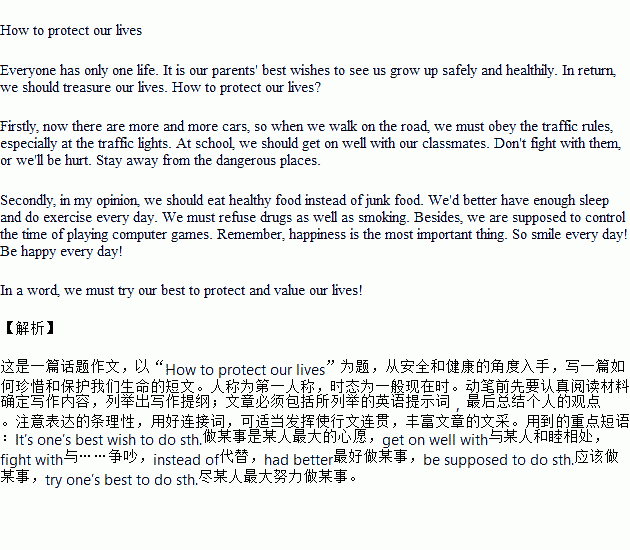��Ŀ����
������
ÿ���˵�����ֻ��һ�Σ���ƽ�������������ֵس����Ǹ�ĸ������Ը���㱣���������ǶԸ�ĸ��õı��������ԡ�How to protect our lives�� Ϊ�⣬�Ӱ�ȫ�ͽ����ĽǶ����֣�дһƪ�����ϧ�ͱ������������Ķ��ġ�
Ҫ��1.100��200�ʣ�2.���в�Ҫ���ֱ�����ʵ��Ϣ��3.������ʾ��ÿ���Ƕ�����ѡ������������д��Ҳ���ʵ����ӡ�
��ʾ�ʣ�traffic accident, fight, drown(��ˮ), fire, electricity, food, exercise, sleep, Internet, smoking, drugs, happiness...
School is a good place for us to study. Yet sometimes, it's easy for us to have accidents there. Experts suggest that right safety training could avoid 80% of these accidents. Here are parts of safety rules in some countries.
In China, fire training at school is common to teach students to deal with emergencies (�������). During the training, students hurry to the playground with a wet cloth covering their mouth. Fire training is held each term. |
In Japan, public elementary schools hold earthquake training once a month. They teach students how to escape during an earthquake without pushing. |
Most US school buildings have fire escapes on each floor. A fire escape has platforms (¶̨) with ladders (����). |
In many middle schools in the UK, students can choose to take a bicycle course. There, they learn how to ride to school safely. |
1.________ countries are mentioned in this passage.
A. Two B. Three C. Four D. Five
2.Students should receive right safety training because ________��
A. it is easy
B. it could avoid most of these accidents
C. it is interesting
D. it is accepted by the teachers
3.If there is a fire, Chinese students should go to the playground hurriedly ________��
A. with a wet cloth covering their mouth
B. by using ladders
C. by bike
D. by pushing each other
4.Public elementary schools in Japan hold earthquake training ________��
A. once a week B. once a month
C. once a year D. every day
5.This passage mainly talks about ________��
A. how to escape from earthquakes
B. how to put out the fire
C. some school safety rules in some countries
D. a bicycle course

